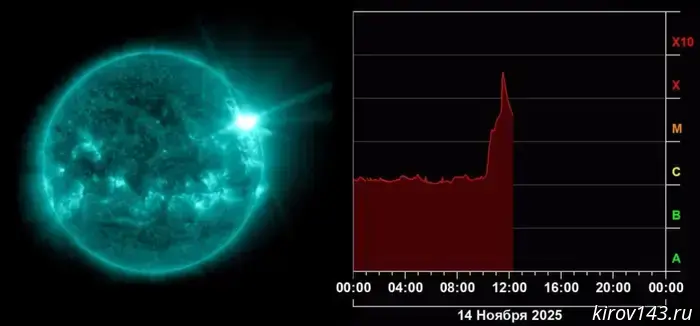
The Sun experienced the second-strongest flare of the year.
On Friday, November 14, an X4.05-class flare was detected on the Sun — the second-strongest energy release of all of 2025. It occurred in the same region as the record X5.15 flare that caused a strong geomagnetic storm on Earth on November 12–13. Scientists note that, in size, this solar region is small, but for several consecutive weeks it has been producing one powerful flare after another. In total, six X-class flares have been recorded recently. At first, specialists believed the new flare posed no threat to Earth: the region was at an angle and the main plasma ejection passed by. However, on November 15 scientific instruments recorded another part of the ejection — faster and directed closer to the Sun–Earth line. This prompted renewed discussion among experts. Different global space weather centers are giving conflicting forecasts: NOAA has already changed its assessment several times; NASA indicates a very wide range of possible consequences — from minor disturbances to a strong storm; Russian specialists remind that this solar region has behaved unpredictably more than once. At present, scientists consider a weak impact on Earth most likely, but a more significant effect cannot be completely ruled out.
Другие Новости Кирова (НЗК)
 The quarantine zone in Kirov was expanded due to a dangerous pest.
In Kirov, the area of the quarantine phytosanitary zone, where new outbreaks of the dangerous pest — the Ussuri polygraph — have been detected, has been expanded.
The quarantine zone in Kirov was expanded due to a dangerous pest.
In Kirov, the area of the quarantine phytosanitary zone, where new outbreaks of the dangerous pest — the Ussuri polygraph — have been detected, has been expanded.
 A lawyer explained who is entitled to compensation for Soviet-era deposits.
Russians who opened bank deposits during the Soviet era are entitled to compensation from the state, said EUS's leading lawyer Yuri Telegin.
A School for SNT Chairmen is launching in Kirov.
Starting November 19, a new academic year will once again begin in Kirov at the School for Chairpersons of Gardening Non-Commercial Partnerships (18+).
Kirov residents may face heavy snowfall tomorrow.
The Telegram channel "Amateur Meteorology in Kirov" warns that on the night of November 15 a cold front from a deep cyclone whose center is located over the Barents Sea will begin to pass through the Kirov Region.
A lawyer explained who is entitled to compensation for Soviet-era deposits.
Russians who opened bank deposits during the Soviet era are entitled to compensation from the state, said EUS's leading lawyer Yuri Telegin.
A School for SNT Chairmen is launching in Kirov.
Starting November 19, a new academic year will once again begin in Kirov at the School for Chairpersons of Gardening Non-Commercial Partnerships (18+).
Kirov residents may face heavy snowfall tomorrow.
The Telegram channel "Amateur Meteorology in Kirov" warns that on the night of November 15 a cold front from a deep cyclone whose center is located over the Barents Sea will begin to pass through the Kirov Region.
 Kirov's road workers received an "icebreaker".
In Kirov, they unveiled a new system that breaks up ice buildup ten times faster than a person.
Kirov's road workers received an "icebreaker".
In Kirov, they unveiled a new system that breaks up ice buildup ten times faster than a person.
 An Antarctic glacier lost one-fifth of its area in just one year.
The Hektoria Glacier in eastern Antarctica is rapidly disintegrating: in just one year it retreated 25 kilometers inland, thinned by 80 meters, and lost about 300 square kilometers of ice — roughly a fifth of its area.
An Antarctic glacier lost one-fifth of its area in just one year.
The Hektoria Glacier in eastern Antarctica is rapidly disintegrating: in just one year it retreated 25 kilometers inland, thinned by 80 meters, and lost about 300 square kilometers of ice — roughly a fifth of its area.
The Sun experienced the second-strongest flare of the year.
Specialists at the Solar Astronomy Laboratory of the Space Research Institute of the Russian Academy of Sciences reported new powerful solar flares that occurred on November 14–15.
